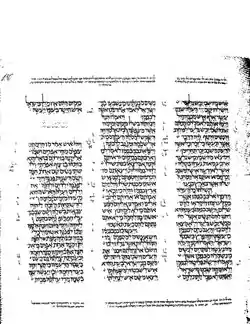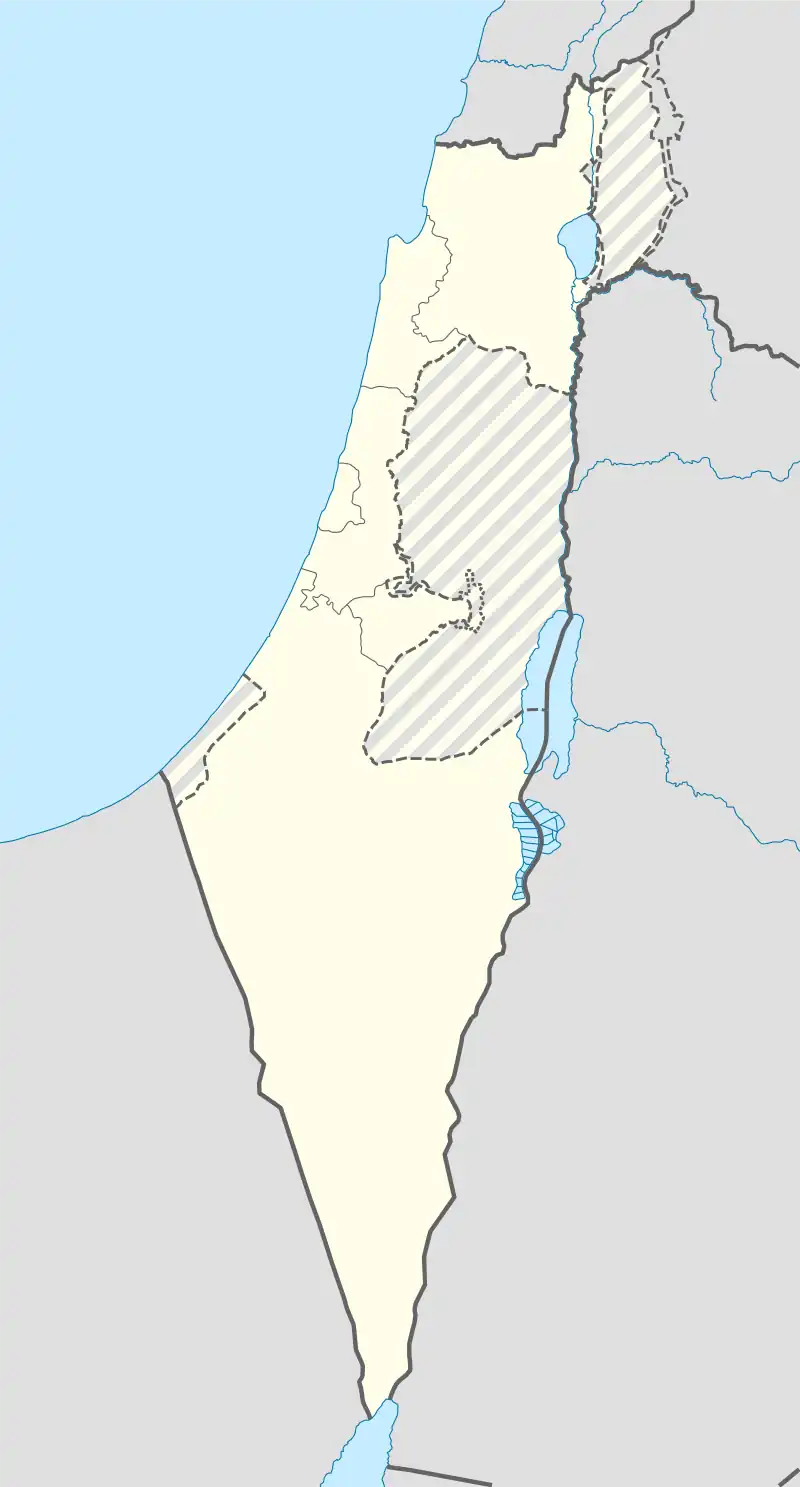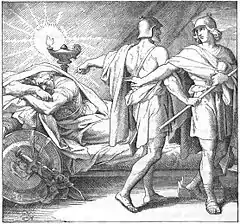| 1 Samuel 26 | |
|---|---|
 The pages containing the Books of Samuel (1 & 2 Samuel) in Leningrad Codex (1008 CE). | |
| Book | First book of Samuel |
| Hebrew Bible part | Nevi'im |
| Order in the Hebrew part | 3 |
| Category | Former Prophets |
| Christian Bible part | Old Testament |
| Order in the Christian part | 9 |
1 Samuel 26 is the twenty-sixth chapter of the First Book of Samuel in the Old Testament of the Christian Bible or the first part of the Books of Samuel in the Hebrew Bible.[1] According to Jewish tradition the book was attributed to the prophet Samuel, with additions by the prophets Gad and Nathan,[2] but modern scholars view it as a composition of a number of independent texts of various ages from c. 630–540 BCE.[3][4] This chapter contains the account of David's escape from Saul's repeated attempts to kill him.[5][6] This is within a section comprising 1 Samuel 16 to 2 Samuel 5 which records the rise of David as the king of Israel.[7]
Text
This chapter was originally written in the Hebrew language. It is divided into 25 verses.
Textual witnesses
Some early manuscripts containing the text of this chapter in Hebrew are of the Masoretic Text tradition, which includes the Codex Cairensis (895), Aleppo Codex (10th century), and Codex Leningradensis (1008).[8] Fragments containing parts of this chapter in Hebrew were found among the Dead Sea Scrolls including 4Q51 (4QSama; 100–50 BCE) with extant verses 9–12, 21–24.[9][10][11][12]
Extant ancient manuscripts of a translation into Koine Greek known as the Septuagint (originally was made in the last few centuries BCE) include Codex Vaticanus (B; B; 4th century) and Codex Alexandrinus (A; A; 5th century).[13][lower-alpha 1]
Places
David spares Saul again (26:1–12)
There are many points of similarity between this narrative and the one contained in 1 Samuel 23:19-24 and 1 Samuel 24:1-22, although the multiple differences prove that these are two separate events.[15][16]
Points of similarities:[15]
- The report of the Ziphites (1 Samuel 23:19; 1 Samuel 26:1).
- David's camp in the hill Hachilah (1 Samuel 23:19; 1 Samuel 26:1, 3).
- Saul's march with 3000 men (1 Samuel 24:2; 1 Samuel 26:2).
- The urge of David's men to kill Saul (1 Samuel 24:4; 1 Samuel 26:8).
- David's refusal to kill the anointed of Jehovah (1 Samuel 24:6; 1 Samuel 26:9, 11).
- Saul's recognition of David's voice (1 Samuel 24:16; 1 Samuel 26:17).
- David's comparison of himself to a flea (1 Samuel 24:14; 1 Samuel 26:20).
Points of differences:[15]
- David spared Saul's life in a cave at En-gedi; but here in Saul's entrenched camp. # Earlier David has to flee in haste, here he could send spies
- Previously David was saved by the news of Philistines' invasion, here David kept a distance and separated by a ravine
- In the first event, David cut off a piece of Saul's cloak, whereas here he took away Saul's spear (a symbol of royal office) and water jug (a symbol of life) as Saul was fast asleep in the camp.[16]
Verse 1
- Now the Ziphites came to Saul at Gibeah, saying, “Is David not hiding in the hill of Hachilah, opposite Jeshimon?” [17]
David's return to Maon could be related with some business of Abigail, now David's wife, who may still control some properties in the area. The Ziphites reported David's presence to Saul, probably out of fear that David may attack them for their former betrayal of him.[15] The fact that Saul at that time was in Gibeah and only 'arose' after hearing the report suggests that he did not pursue David any more until being excited by the Ziphites of a good opportunity to ambush David.[18]
David reproved Abner as Saul acknowledged his sin against David (26:13–25)
After leaving Saul's camp undetected and standing in a safe distance, David berated Abner for failing to protect the king, while also implying to the failure to recognize the king-elect (verse 14). However, Saul did recognize David's voice, and became regretful of his own action to pursue. In view of his decision to leave Israelite territory, David pled with Saul not to 'let his blood fall to the earth' while in exile.[19] This was actually the last time Saul met David, and as they parted for good, Saul gave his final blessings to David.[20]
Verse 20
- "Now therefore, let not my blood fall to the earth away from the presence of the LORD, for the king of Israel has come out to seek a single flea like one who hunts a partridge in the mountains."[21]
- "Away in the presence of to be Lord": David implied that he would not be able to properly worship the Lord if he left the land of Israel, which he was planning to do (1 Samuel 27:1).[22]
See also
- Related Bible parts: 1 Samuel 24, 1 Samuel 25
Notes
- ↑ The whole book of 1 Samuel is missing from the extant Codex Sinaiticus.[14]
References
- ↑ Halley 1965, pp. 182–183.
- ↑ Hirsch, Emil G. "SAMUEL, BOOKS OF". www.jewishencyclopedia.com.
- ↑ Knight 1995, p. 62.
- ↑ Jones 2007, p. 197.
- ↑ Jones 2007, p. 209.
- ↑ Coogan 2007, p. 433 Hebrew Bible.
- ↑ Jones 2007, p. 207.
- ↑ Würthwein 1995, pp. 35–37.
- ↑ Ulrich 2010, p. 286.
- ↑ Dead sea scrolls - 1 Samuel
- ↑ Fitzmyer 2008, p. 35.
- ↑ 4Q51 at the Leon Levy Dead Sea Scrolls Digital Library
- ↑ Würthwein 1995, pp. 73–74.
- ↑
 This article incorporates text from a publication now in the public domain: Herbermann, Charles, ed. (1913). "Codex Sinaiticus". Catholic Encyclopedia. New York: Robert Appleton Company.
This article incorporates text from a publication now in the public domain: Herbermann, Charles, ed. (1913). "Codex Sinaiticus". Catholic Encyclopedia. New York: Robert Appleton Company. - 1 2 3 4 Exell, Joseph S.; Spence-Jones, Henry Donald Maurice (Editors). On "1 Samuel 26". In: The Pulpit Commentary. 23 volumes. First publication: 1890. Accessed 24 April 2019.
- 1 2 Jones 2007, p. 212.
- ↑ 1 Samuel 26:1 NKJV
- ↑ Benson, Joseph. "Commentary on the Old and New Testaments". 1 Samuel 26. Accessed 9 Juli 2019.
- ↑ Jones 2007, p. 213.
- ↑ Evans 2018, p. 267.
- ↑ 1 Samuel 26:20 ESV
- ↑ Evans 2018, p. 266.
Sources
Commentaries on Samuel
- Auld, Graeme (2003). "1 & 2 Samuel". In James D. G. Dunn and John William Rogerson (ed.). Eerdmans Commentary on the Bible. Eerdmans. ISBN 9780802837110.
- Bergen, David T. (1996). 1, 2 Samuel. B&H Publishing Group. ISBN 9780805401073.
- Chapman, Stephen B. (2016). 1 Samuel as Christian Scripture: A Theological Commentary. Wm. B. Eerdmans Publishing Company. ISBN 978-1467445160.
- Evans, Paul (2018). Longman, Tremper (ed.). 1-2 Samuel. The Story of God Bible Commentary. Zondervan Academic. ISBN 978-0310490944.
- Gordon, Robert (1986). I & II Samuel, A Commentary. Paternoster Press. ISBN 9780310230229.
- Hertzberg, Hans Wilhelm (1964). I & II Samuel, A Commentary (trans. from German 2nd edition 1960 ed.). Westminster John Knox Press. p. 19. ISBN 978-0664223182.
- Tsumura, David Toshio (2007). The First Book of Samuel. Eerdmans. ISBN 9780802823595.
General
- Breytenbach, Andries (2000). "Who Is Behind The Samuel Narrative?". In Johannes Cornelis de Moor and H.F. Van Rooy (ed.). Past, Present, Future: the Deuteronomistic History and the Prophets. Brill. ISBN 9789004118713.
- Coogan, Michael David (2007). Coogan, Michael David; Brettler, Marc Zvi; Newsom, Carol Ann; Perkins, Pheme (eds.). The New Oxford Annotated Bible with the Apocryphal/Deuterocanonical Books: New Revised Standard Version, Issue 48 (Augmented 3rd ed.). Oxford University Press. ISBN 978-0195288810.
- Fitzmyer, Joseph A. (2008). A Guide to the Dead Sea Scrolls and Related Literature. Grand Rapids, MI: William B. Eerdmans Publishing Company. ISBN 9780802862419.
- Halley, Henry H. (1965). Halley's Bible Handbook: an abbreviated Bible commentary (24th (revised) ed.). Zondervan Publishing House. ISBN 0-310-25720-4.
- Hayes, Christine (2015). Introduction to the Bible. Yale University Press. ISBN 978-0300188271.
- Jones, Gwilym H. (2007). "12. 1 and 2 Samuel". In Barton, John; Muddiman, John (eds.). The Oxford Bible Commentary (first (paperback) ed.). Oxford University Press. pp. 196–232. ISBN 978-0199277186. Retrieved February 6, 2019.
- Klein, R.W. (2003). "Samuel, books of". In Bromiley, Geoffrey W (ed.). The International Standard Bible Encyclopedia. Eerdmans. ISBN 9780802837844.
- Knight, Douglas A (1995). "Chapter 4 Deuteronomy and the Deuteronomists". In James Luther Mays, David L. Petersen and Kent Harold Richards (ed.). Old Testament Interpretation. T&T Clark. ISBN 9780567292896.
- Ulrich, Eugene, ed. (2010). The Biblical Qumran Scrolls: Transcriptions and Textual Variants. Brill.
- Würthwein, Ernst (1995). The Text of the Old Testament. Translated by Rhodes, Erroll F. Grand Rapids, MI: Wm. B. Eerdmans. ISBN 0-8028-0788-7. Retrieved January 26, 2019.
External links
- Jewish translations:
- Shmuel I - I Samuel - Chapter 26 (Judaica Press). Hebrew text and English translation [with Rashi's commentary] at Chabad.org
- Christian translations:
- Online Bible at GospelHall.org (ESV, KJV, Darby, American Standard Version, Bible in Basic English)
- 1 Samuel chapter 26. Bible Gateway

